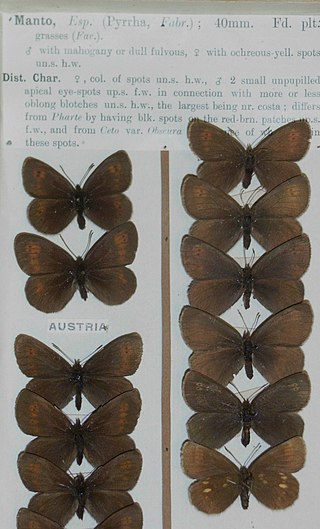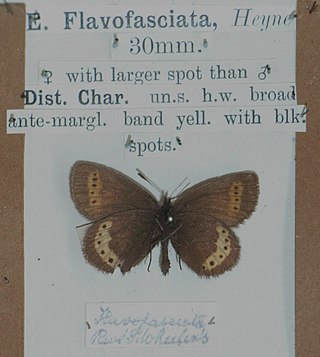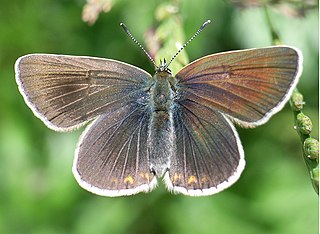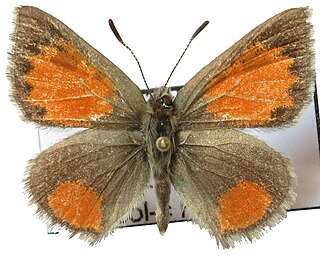
The map is a butterfly of the family Nymphalidae.

The Raetzer's ringlet is a species of butterfly in the family Nymphalidae. It is found in Italy and Switzerland. Its natural habitat is temperate grassland. It is one of the rarest European butterflies, having not more than six or seven populations.

Erebia epistygne, the spring ringlet, is a species of butterfly in the family Nymphalidae. It is found in France and Spain. Its natural habitat is temperate grassland.

Parnassius tenedius, the tenedius Apollo, is an east Palearctic member of the snow Apollo genus (Parnassius) of the swallowtail family (Papilionidae). Populations range from Siberia and the Far East of Russia to the western Chukchi Peninsula, Mongolia and north China. The larva feeds on Corydalis species. In the northern part of its range it is a low altitude butterfly; further south it is montane.

Lasiommata maera, the large wall brown, is a butterfly in the family Nymphalidae.

The Lapland ringlet is a member of the subfamily Satyrinae of the family Nymphalidae. It is restricted to sunny patches in very damp spruce and pine forests and forested unmanaged peatlands. The larva feeds on various grasses and related plants and winters twice. A dry period in the habitat will result in the decline of the species.

The yellow-spotted ringlet is a member of the subfamily Satyrinae of the family Nymphalidae. It is associated with (sub)alpine meadows at 900–2,500 m above sea level. It is found in the Alps, the Pyrenees, the Cantabrian Mountains, the Massif Central, the Vosges Mountains, the Carpathian Mountains and the mountains of Herzegovina.

The yellow-banded ringlet is a member of the subfamily Satyrinae of the family Nymphalidae. It is a high mountain butterfly found in a small area of the Alps in Switzerland and Italy.

Coenonympha arcania, the pearly heath, is a butterfly species belonging to the family Nymphalidae.

Melitaea didyma, the spotted fritillary or red-band fritillary, is a Palearctic butterfly of the family Nymphalidae.

Melitaea phoebe, the knapweed fritillary, is a butterfly of the family Nymphalidae. It is found in the Palearctic realm, except the northernmost locations. It used to include Melitaea telona, recently revalidated as a distinct cryptic species.

Polygonia egea, the southern comma, is a butterfly of the family Nymphalidae. It is found in southern Europe.

Eumedonia eumedon, the geranium argus, is a butterfly of the family Lycaenidae. It is found in the Palearctic realm. This butterfly has been included in the genera Plebejus, Plebeius, Polyommatus and Aricia, but recent molecular studies have demonstrated that Eumedonia is a valid genus, different from the previous genera mentioned.

Chazara briseis, the hermit, is a butterfly species belonging to the family Nymphalidae. It can be found in North Africa, southern Europe, Asia Minor, the Caucasus, Kazakhstan, Central Asia through Afghanistan, and north-western China and Tuva. It is found on steppe and in other dry grassy places between 500 and 2,500 meters.

Erebia melampus, the lesser mountain ringlet, is a member of the subfamily Satyrinae of the family Nymphalidae.

Iolana iolas, the iolas blue, is a butterfly of the family Lycaenidae. It is found in northern Africa, southern Spain, southern France, southern Europe, Asia Minor and Iran. The wingspan of the male is 18–21 mm. The flight period is May to June in rocky places at around 2,000 m. The larva feeds on Colutea arborescens.

Arethusana is a butterfly genus from the subfamily Satyrinae of the brush-footed butterfly family (Nymphalidae). It is composed of only one species, Arethusana arethusa, the false grayling.

Tomares callimachus, the Caucasian vernal copper, is a butterfly of the family Lycaenidae. It is found in Anatolia, Iraq, Iran, the Caucasus, and Transcaucasia.

Tomares nogelii is a small butterfly found in the Palearctic that belongs to the blues family.

Euphydryas intermedia synonym ichnea is a small butterfly found in the Palearctic that belongs to the browns family. It occurs up to 2200 m above sea level.





















